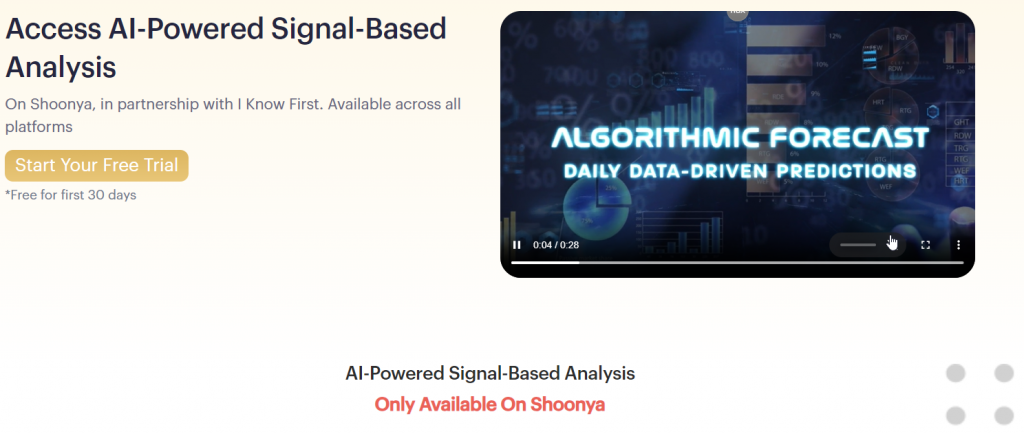It is important to verify the accuracy of AI trading platforms which predict and analyze stock prices. This will assure you are using an accurate tool. Here are the top 10 methods to assess these platforms.
1. Backtesting Results
What to look out for Make sure the software allows for backtesting, which will allow you to assess how predictions would have performed from historical data.
What is important Backtesting is a way to confirm the AI model's accuracy by comparing predictions to actual outcomes from the past.
Look for platforms that offer the capability of setting backtesting parameters.
2. Real-time Performance Tracking
What to look out for: Determine how the platform's performance is compared with the current market conditions.
What's important It is because the platform's real-time performance is a better gauge of its efficiency than relying solely on historical backtesting.
TIP: Make use of an account demo or free trial to monitor real-time predictions and compare them to the actual market trends.
3. Prediction Error Metrics
What to be looking for: To measure the accuracy of your predictions, evaluate measures like mean absolute error (MAE), root mean squared error (RMSE) as well as R-squared.
Why it matters: These measures are a way to gauge how closely predictions match actual results.
Tips: Platforms that allow openly shared metrics are usually more transparent.
4. The Winning Rate and the Ratio of Success
What to look out for Check the platform's success ratio and winning rate (percentage accurate prediction).
What is important Why it matters: High success rates and win percentages indicate greater accuracy in predicting the future and a higher chance of generating profits.
Tip: Be cautious of platforms that claim false win rates (e.g. 90%) %+), as there is no perfect system.
5. Benchmarking Market Indicators
What to watch out for: Compare performance and forecasts of the platform to the major market indexes.
What it does: It helps determine whether the platform is performing better or more than the market as a whole.
Find out if the performance is consistent over time and not only in the short term.
6. Consistency in Market Conditions
What to look out for Find out how the platform's performance is affected by various market conditions (bull or bear markets or high volatility).
Why it matters The platform that is robust must perform effectively regardless of market conditions and not only when the market is favorable.
Try the platform's predictions in volatile markets or during markets that are down.
7. Transparency in Methodology
What to Look For: Understand the AI algorithms and models that are employed (e.g. neural networks, reinforcement learning).
What's important: Transparency allows you to evaluate the scientific and technical reliability of a system.
Beware of platforms that employ models with "black boxes" without explaining the process by which predictions are made.
8. Independent testing and User Reviews
What to Look for When choosing a platform: Read the reviews of users and search for independent tests or third-party evaluations.
What is important: Independent testing and reviews provide unbiased insight into the reliability of the platform.
Check out forums like Reddit or copyright to read what others have to say about their experiences.
9. Risk-Adjusted Returns
What to Watch Out For What to Look For: Assess the platform's performance by using risk-adjusted metrics like Sharpe Ratios or Sortino Rateios.
Why it is Important The metrics are based on the level at which risk is taken in order to earn returns. This provides an overall view of the performance.
Sharpe Ratio can be a useful indicator of risk-adjusted returns.
10. Long-term Track Record
What to look for: Assess the platform's performance over a long period (e.g., 3-5 years).
What's important Why it's Important: Long-term results are a far more reliable indicator of reliability as compared to short-term results.
Beware of platforms that promise only short-term success or results that have been cherry-picked.
Bonus Tip - Test your account with a demo version
Utilize a demo account, or a free trial to test the predictions of the platform in real-time, without risking any real money. This gives you the opportunity to test accuracy and performance.
Use these guidelines to assess the accuracy, efficiency, and reliability of AI stock prediction and analysis platforms. You can then choose the one that is most compatible with both your trading goals, and your risk tolerance. Be aware that none of the trading platforms is perfect, and the best strategy is to blend AI insights with personal research. Read the recommended best stocks to invest in recommendations for blog advice including ai stock trading bot free, ai stock, investment ai, stock ai, best ai for trading, ai stocks to invest in, invest in ai stocks, ai trading bots, stock ai, ai stocks to invest in and more.

Top 10 Tips To Evaluate The Speed And Latency Of Ai Stock Predicting/Analyzing Trading Platforms
For high-frequency, algorithmic, and active traders in particular speeds and latencies are key factors when evaluating AI platforms for stock forecasting and analyzing. Milliseconds of delay could influence the execution of trades as well as profitability. Here are ten top suggestions to determine the speed and latency of these platforms.
1. Evaluate Real-Time Data Feeds
Data delivery speed Make sure the platform delivers live data (e.g. sub-millisecond delay).
Find out the distance of the source to major exchanges.
Data compression: Determine if your platform utilizes effective data compression techniques in order to accelerate the speed of data transfer.
2. Test Trade Execution Time
Order processing: The platform's ability to process and execute trades fast after an order is submitted.
Direct market access: Make sure that the platform allows direct orders to be sent to the exchange.
Execution Reports: Check if your platform provides detailed reports on the execution of orders, as well as timestamps.
3. Assess Platform Response
User interface speed (UI): Measure how fast the platform's user interface responds your inputs.
Chart updates Check if charts and visualizations are updated in real-time update that is not lag.
Performance of mobile apps If you're using a mobile app make sure that it's at the same speed as a desktop version.
4. Check for low-latency network infrastructure
Servers' location Check that the platform uses a low-latency servers that are close to financial hubs and exchanges.
Co-location: If the exchange offers co-location, you are able to place your trading algorithms on servers near the exchange.
High-speed networks: Determine that the platform utilizes fiber-optic networks with high speeds or other low-latency technologies.
5. Check the backtesting speed and simulation speed.
Historical data processing: Test the speed at which the platform processes and analyzes old data to test backtesting.
Simulation latency: Ensure that the platform can simulate trading in real-time without noticeable delay.
Parallel processing: Check that the system is running parallel processing or distributed computing, to speed complicated computations.
6. Evaluation of Latency in API
API responses: Determine how fast APIs can respond to requests (e.g. getting data from the platform, or placing orders).
Rate limits: Make sure that the API has adequate limits on rates so that there are no delays during high-frequency trading takes place.
WebSockets support: Ensure that the platform utilizes WebSockets protocol for low-latency, real-time streaming of data.
7. Test Platform Stability when Loaded
High-volume trades to test the platform's responsiveness and stability, simulate high-volume scenarios.
Try the platform out in periods when there is a lot of volatility on the market to ensure it is able to handle sudden changes in price.
Stress testing: Check whether the platform has the tools to stress test your strategies in extreme circumstances.
8. Assess the connectivity and network of your choice
Internet speed requirements. Be sure your connection speed is sufficient to meet the recommended speed of the platform for maximum performance.
Verify connections that are not redundant.
VPN latency: When you use the VPN platform, check if the latency is significant and also if there are alternative options.
9. Check for Speed Optimization Features
Pre-trade Analytics: Ensure that the platform provides pre-trade analysis to improve order routing, execution speed and other variables.
Smart order routing: Check whether your application is using SOR to determine the most cost-effective and fastest execution location.
Monitoring latency Make sure your platform lets you analyse and track your latency live.
Review User Feedback & Benchmarks
User reviews: Study feedback from users to evaluate the platform's speed and latency performance.
Third-party benchmarks by third parties. You can find benchmarks from independent sources or reviews that evaluate the performance of a platform against other platforms.
Case studies: Verify whether a platform offers case studies or testimonies that demonstrate the low-latency capabilities.
Bonus Tips
Trial period: Try a free trial or demo to test the platform's speed and latency in real-world scenarios.
Support for customer - Make sure there is a support service available for issues relating to latency, optimization or any other problems.
Hardware requirements: Check whether you require specific hardware for optimal performance (e.g. high-performance computers).
With these suggestions, it is possible to accurately assess the speed, latency, and accuracy of AI software for analyzing and predicting stocks. This allows you to select a system that meets your needs for trading and minimize any delays. The ability to reduce latency is crucial for algorithmic or high-frequency traders where even a small delay could be a significant factor in their performance. View the recommended best ai stock recommendations for website info including ai bot for copyright trading, ai trading, ai trading, invest in ai stocks, copyright ai bot, free ai investing app, best ai for stock trading, trader ai intal, chart analysis ai, ai stock prediction and more.
